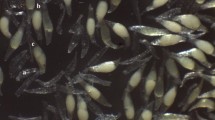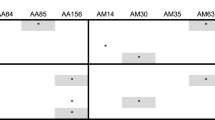Abstract
Factors influencing the success of hand cross-pollination of broccoli were investigated. A number of experimental variables were shown to have no effect, whereas age of flower and storage of pollen had minor effects. The bulk of the variability was found to be associated with specific parental combinations. The significance of this variability is discussed in terms of the nature of the incompatibility and the influence of such behavior on the breeding program.
Similar content being viewed by others
References
Attia M. S. and Munger H. M., Self-incompatibility and the production of hybrid cabbage seed. Amer. Soc. Hort. Sci. Proc. 56 (1950): 363–368.
Bateman A. J., Self-incompatibility systems in Angiosperms. III Cruciferae. Heredity 9 (1955): 53–68.
Detjen L. R., Sterility in common cabbage (Brassicae oleracea L.). Mem. Hort. Soc. New York, 3 (1929): 277.
Kakizaki Y., Studies on the genetics and physiology of self- and cross-incompatibility in the common cabbage. Jap. Jour. Bot. 5 (1930): 134–208.
Moore J. F. and Anstey T. H., A study of the degree of natural selfing in green sprouting broccoli, a normally cross-pollinated crop. Amer. Soc. Hort. Sci. Proc. 62 (1954): 440–442.
Odland M. L. and Isenberg F. M. R., The value of asexual propagation in the production of F1 hybrid cabbage seed. Amer. Soc. Hort. Sci. Proc. 56 (1950): 372–376.
Odland M. L. and Noll C. J., The utilization of cross-compatibility and self-incompatibility in the production of F1 hybrid cabbage. Amer. Soc. Hort. Sci. Proc. 55 (1950): 390–402.
Pearson, O. H., Breeding plants of the cabbage group. Calif. Agric. Exp. Sta., Bull. 532 (1932): 22 pp.
Rowlands D. G., Fertility studies in the field bean (Vicia faba L.) I. Cross- and self-fertility. Heredity 15 (1960): 161–173.
Sampson D. R., The genetics of self- and cross-incompatibility in Brassica oleracea. Genetics 42 (1957): 252–263.
Sawant A. C., Semilethal complementary factors in a tomato species hybrid. Evolution 10 (1956): 93–96.
Sears E. R., Cytological phenomena connected with self-sterility in the flowering plants. Genetics 22 (1937): 130–181.
Thompson K. F. and Howard H. W., Self-incompatibility in marrow-stem kale, Brassica oleracea var. acephala II. Methods for the recognition in inbred lines of plants homozygous for S alleles. Jour. Genetics 56 (1959): 325–340.
Warnock S. J. and Hagedorn D. J., Germination and storage of pea (Pisum sativum L.) pollen. Agron. Jour. 48 (1956): 347–252.
Author information
Authors and Affiliations
Additional information
Formerly Assistant Horticulturist, Vegetable Crops Research, Department of Horticulture, Western Washington Experiment Station, Puyallup Washington Agricultural Experiment Stations, Scientific Paper no. 2144 Work was conducted under Project 1288
Rights and permissions
About this article
Cite this article
Martin, F.W. Factors affecting seed set in cross-pollinations of green-sprouting broccoli (Brassica oleracea var. Italica). Euphytica 11, 81–86 (1962). https://doi.org/10.1007/BF00044809
Received:
Issue Date:
DOI: https://doi.org/10.1007/BF00044809




